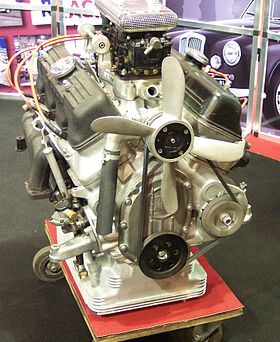| This article needs additional citations for verification. Please help improve this article by adding citations to reliable sources. Unsourced material may be challenged and removed. Find sources: "Lancia V6 engine" – news · newspapers · books · scholar · JSTOR (January 2019) (Learn how and when to remove this message) |
| Lancia V6 engine | |
|---|---|
 | |
| Overview | |
| Manufacturer | Lancia |
| Production | 1950–1970 |
| Layout | |
| Configuration | Naturally aspirated 60° V6 |
| Displacement | 1.8 L; 107.0 cu in (1,754 cc) 2.0 L; 121.5 cu in (1,991 cc) 2.3 L; 138.3 cu in (2,266 cc) 2.5 L; 149.6 cu in (2,451 cc) 2.5 L; 150.0 cu in (2,458 cc) 2.8 L; 169.3 cu in (2,775 cc) |
| Cylinder bore | 70 mm (2.76 in) 72 mm (2.83 in) 78 mm (3.07 in) 80 mm (3.15 in) 85 mm (3.35 in) |
| Piston stroke | 76 mm (2.99 in) 81.5 mm (3.21 in) 85.5 mm (3.37 in) 82 mm (3.23 in) |
| Cylinder block material | Light alloy |
| Cylinder head material | Aluminium alloy |
| Valvetrain | OHV 2 valves x cyl. |
| Combustion | |
| Fuel system | Carburetor |
| Fuel type | Petrol |
| Cooling system | Water-cooled |
| Output | |
| Power output | 56–152 hp (42–113 kW; 57–154 PS) |
In 1950, Lancia introduced one of the world's first production V6 engines in the Lancia Aurelia. The engine was the work of Francesco De Virgilio and was developed to solve the vibration problems Lancia had experienced with its V4 engines. This was achieved by setting the vee angle to 60 degrees. It remained in production through 1970. Lancia used V6 engines in road and sports cars, the D20 had a 60 degree quad cam V6 2962 cc 217 bhp (162 kW; 220 PS) engine and the D24 3300 cc V6 engine.
Aurelia
The first-generation Aurelia engines were produced from 1950 through 1967.
1800
The 1.8 L; 107.0 cu in (1,754 cc) 1800 was the first V6. Bore and stroke was 70 mm × 76 mm (2.76 in × 2.99 in).
- 1950 Lancia Aurelia
2000
The engine was expanded to 2.0 L; 121.5 cu in (1,991 cc) for 1951's B21 Aurelia. Bore and stroke was 72 mm × 81.5 mm (2.83 in × 3.21 in).
- 1951-1952 Lancia Aurelia
2300
A 2.3 L; 138.3 cu in (2,266 cc) version was also produced.
2500
The largest of the original Aurelia engines was the 2.5 L; 149.6 cu in (2,451 cc) 2500 introduced in 1953. It was still undersquare at 78 mm × 85.5 mm (3.07 in × 3.37 in) bore and stroke.
- 1953-1957 Lancia Aurelia
Flaminia
The engine's severe undersquare design was addressed for the 1957 Flaminia version. This lasted in production through 1970.
2500
The new engine displaced 2.5 L; 150.0 cu in (2,458 cc) from a much less undersquare 80 mm × 82 mm (3.15 in × 3.23 in) bore and stroke.
- 1957-1970 Lancia Flaminia
2800
The final version was the 2.8 L; 169.3 cu in (2,775 cc) engine. Bore was now 85 mm (3.35 in) and stroke remained at 82 mm (3.23 in) as in the 2500.
- 1957-1970 Lancia Flaminia
Later V6-engined Lancias
Later Lancias were powered by V6 engines designed by other manufacturers, with the Ferrari Dino V6 powering the Stratos, the PRV V6 powering early Themas, the Alfa Romeo Busso V6 powering later versions of the Thema, and versions of the Kappa and Thesis and the Chrysler Pentastar V6 in the badge-engineered 300C-based Thema.
Notes
- ^ "Lancia Coupés & Convertibles". ritzsite.net. Retrieved 2007-09-15.
- "Lancia Heritage". uniquecarsandparts.com.au. Retrieved 2007-09-15.
- "Lancia Aurelia: B10 engine".
| Lancia | |||||||||||||
|---|---|---|---|---|---|---|---|---|---|---|---|---|---|
| A marque of Stellantis | |||||||||||||
| Passenger cars |
| ||||||||||||
| Buses | |||||||||||||
| Trucks | |||||||||||||
| Vans | |||||||||||||
| Military vehicles | |||||||||||||
| Motorsport |
| ||||||||||||
| People |
| ||||||||||||
| Technologies | |||||||||||||
| Museum |
| ||||||||||||
| Buildings | |||||||||||||
| Bike | |||||||||||||
| Boat | |||||||||||||